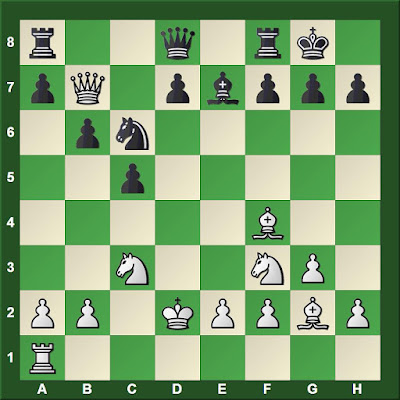I played well that night, but could only manage a draw. A draw was still a good result for me against Michael, but my ambitions called for more. Three months later, we played another tournament game with the same first seven moves. I tried a different eighth move and lost, just as I had lost previously in 2007.
After last week's games, I thought there was a good chance that I would be playing Michael this week in the Spokane Chess Club Winter Championship. I started reviewing our games in the French Defense, thinking that I would have Black. On Monday, I received the email that told me that I had White against Michael. I started some work on the Queen's Indian Defense. Over the course of the next three days, I probably looked at four dozen grandmaster games.
I did not expect that Sergey Karjakin's 2007 miniature against Falko Bindrich would be helpful, but was aware of the possibility. My study convinced me that the most likely scenario was that we would reach a position out of the opening where I would not feel hopelessly lost in terms of ideas concerning how to proceed. With some luck, I might get a little ahead on the clock thanks to my preparation. In a game 90 + five second delay, being ahead on the clock can help.
Karjakin's miniature is astounding and should certainly be studied by players of the Queen's Indian Defense.
Karjakin,Sergey (2686) -- Bindrich,Falko (2469) [E17]
EU-ch 8th Dresden (10), 13.04.2007
1.Nf3 Nf6 2.c4 b6 3.g3 Bb7 4.Bg2 e6 5.d4 Be7 6.Nc3 0–0 7.Qc2 c5 8.d5 exd5 9.cxd5 Nxd5 10.Qe4!
Black to move
10...Nb4 11.Qxb7 N8c6 12.Bf4 g5 13.0–0–0 gxf4 14.a3 1–0
When the diagram position appeared on my board last night, I realized that I could not remember all of this game. I realized that I had entered a tactical battle where my queen could very well become trapped.
We both had used about five minutes to reach this position. Now my opponent spent eight minutes. I also used his thinking time trying to recall, and to calculate for myself. If my queen becomes trapped, I lose.
Stripes,James (1791) -- Cambareri,Michael (1993) [E17]
SCC Club Championship (4), 09.02.2017
1.d4 Nf6 2.Nf3
My move order reserves the possibility of going into the London System (see "Fiddling with the London System").
2...b6 3.c4 e6 4.g3 Bb7 5.Bg2 Be7
White to move
6.Nc3
Castling is White's most popular move by far. When I complained to my friend John Julian some years ago about my frustration with Michael's set-up in the Queen's Indian Defense, his advice was, "don't let him set it up." My choice of White's second most popular move was the first step in hindering his tableau.
6...0–0 7.Qc2
Delaying castling in this manner runs the risk that my king might get stuck in the center, or that I would need to expend the time to castle by hand. But, preventing Ne4 and f5 by Black was my intent.
7...c5
Black also plays 7...d5 or 7...Na6 here. There are other obscure possibilities that do not seem as good. With either of these two moves, I would be in for a long struggle, but felt that I had looked at enough games that I might play well enough for a draw.
8.d5 exd5 9.cxd5 Nxd5?!
Annotations on Karjakin's miniature recommend 9...Bxd5.
10.Qe4!
Michael admitted after the game that he did not anticipate this move. See diagram in Karjakin game above.
10.Ng5 was played in Tomovic -- Pirc, Zagreb 1949.
10...Nb4
10...f5 11.Qc4 b5 12.Qxb5 Nb6 13.Be3 Na6 14.0–0 was drawn in 52 moves in Lagno,K (2557) --Dzagnidze,N (2535), Tbilisi 2012
11.Qxb7 N8c6 12.Bf4 Nc2+
12...g5 13.0–0–0 gxf4 14.a3 1–0 Karjakin,S (2686) -- Bindrich,F (2469)/Dresden 2007 (presented above).
13.Kd2 Nxa1 14.Rxa1
Black to move
14...Rc8N
14...Bf6 15.Rd1 Bxc3+ 16.bxc3 Qf6 17.Bh3 and White won in 33 moves in Gajewski,G (2515) --Hernandez Carmenates,H (2524), Calvia 2006.
At this point in the game, I could not recall whether we were still following the Karjakin game or not. I had to do the tactical and positional calculation on my own. However, the knowledge that I was winning in the objective sense after 10.Qe4 gave me confidence. I labored to combine confidence with a clear head and find strong moves.
15.Nd5!
"This move killed me." M. Cambareri during postgame analysis.
15... d6 16.Rd1 Bf6 17.Bh3 1–0
At this point in the game, I had used sixteen minutes, while Michael had used 34. He thought for another 34 minutes, then tipped his king.
While he was thinking, I walked to stay calm, frequently returning to the board trying to anticipate his move and my response. I thought that 17...Na5 was the most testing.















Nice game! You theoried him!
ReplyDeleteMy prophesy is already coming true!
Thanks Todd.
ReplyDeleteGreat game for sure
ReplyDelete